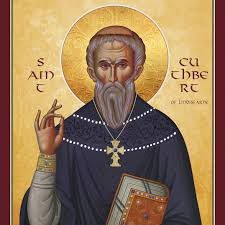St Cuthbert of Lindisfarne (c. 634 – March 20, 687) was a British monk and bishop who was one of the most important saints of England during the early Middle Ages.
St Cuthbert was of Northumbrian origin, probably from the neighbourhood of Dunbar, in modern-day Scotland. While still a boy, employed as a shepherd, he thought that he saw one night the soul of Aidan carried to heaven by angels and thereupon went to the monastery of Old Melrose and became a monk (651). Soon afterwards, however, he became a soldier for several years.
After his return to the monastery, his fame for piety, diligence, and obedience quickly grew. When Alchfrith, king of Deira, founded a new monastery at Ripon, St Cuthbert became its entertainer of guests.
After the Synod of Whitby St Cuthbert was called to Lindisfarne, where he stayed for many years. However, In 676 he adopted the solitary life and retired to a cave. After a time he settled on one of the Farne Islands, south of Lindisfarne, and gave himself more and more to austerities. At first, he would receive visitors and wash their feet, but later he confined himself to his cell and opened the window only to give his blessing. While on the Farne Islands, he instituted special laws to protect the Eider ducks and other seabirds nesting on the islands; these may have been the first bird protection laws anywhere in the world, showing great stewardship.
After nine years, he was called upon to return to Lindisfarne as bishop and was consecrated at York by Archbishop Theodore and six bishops, on 26 March, 685. After Christmas, 686, however, he returned to his cell on Inner Farne Island, (2 miles from Bamburgh, Northumberland), which was where he eventually died. He was buried at Lindisfarne.
Legend has it that, when St Cuthbert’s burial casket was opened some years after his death, his body was found to have been perfectly preserved. This apparent miracle led to the steady growth of St Cuthbert’s fame, to the point where he became the most popular saint of North England. Numerous miracles were attributed to him and to his remains.
St Cuthbert is the Patron saint of our school and his feast day is March 20th, in honour of this in school, we have named our set groups are S and C, representing Saint Cuthbert. Each year we celebrate St Cuthbert’s feast day. This is a drop down day and all activities are based on celebrating our school values and our mission statement, as well as what it means to be a member of the St Cuthbert’s school community.

